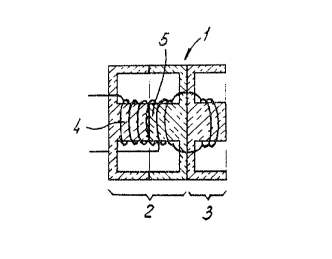Some of the information on this Web page has been provided by external sources. The Government of Canada is not responsible for the accuracy, reliability or currency of the information supplied by external sources. Users wishing to rely upon this information should consult directly with the source of the information. Content provided by external sources is not subject to official languages, privacy and accessibility requirements.
Any discrepancies in the text and image of the Claims and Abstract are due to differing posting times. Text of the Claims and Abstract are posted:
| (12) Patent: | (11) CA 2086149 |
|---|---|
| (54) English Title: | BUILT-IN CHIP TRANSPONDER WITH ANTENNA COIL |
| (54) French Title: | TRANSPONDEUR SUR PUCE INCORPORE A UN CIRCUIT DE BOBINE D'ANTENNE |
| Status: | Deemed expired |
| (51) International Patent Classification (IPC): |
|
|---|---|
| (72) Inventors : |
|
| (73) Owners : |
|
| (71) Applicants : | |
| (74) Agent: | KIRBY EADES GALE BAKER |
| (74) Associate agent: | |
| (45) Issued: | 1997-12-23 |
| (22) Filed Date: | 1992-12-23 |
| (41) Open to Public Inspection: | 1993-07-01 |
| Examination requested: | 1993-12-22 |
| Availability of licence: | N/A |
| (25) Language of filing: | English |
| Patent Cooperation Treaty (PCT): | No |
|---|
| (30) Application Priority Data: | ||||||
|---|---|---|---|---|---|---|
|
Abstract.
An antenna circuit to be used in conjunction with a chip
transponder such that the antenna circuit serves for both the reception
of interrogative signals intended for the transponder as well as for
response signals that are to be transmitted by the transponder. The
antenna circuit has at least one magnetic circuit of high µ material, and
is formed of ceramic core means, that have been built into a depression
in a thick-walled surface intended to receive the chip transponder. This
thick-walled surface may be of metal. The ceramic core means comprise at
least a ceramic core resonator and half a ceramic core that functions as
an antenna with its open side facing outward. In one aspect, the ceramic
core resonator and the half ceramic core antenna are coupled by means of
one or more secondary coils of the closed ceramic core, which also form
the coils of the half ceramic core antenna. In another aspect, the
secondary coil forms a resonating circuit with at least one capacitive
element in series. In yet another aspect, the ceramic core resonator and
the half ceramic core antenna are formed by one and the same half ceramic
core, which may be closed in part by a magnetic covering disk. In yet
another aspect, the resonator may consist of a half ceramic core which is
placed against the back of the half ceramic core antenna.
DEJA TRADUIT.
Note: Claims are shown in the official language in which they were submitted.
Note: Descriptions are shown in the official language in which they were submitted.

For a clearer understanding of the status of the application/patent presented on this page, the site Disclaimer , as well as the definitions for Patent , Administrative Status , Maintenance Fee and Payment History should be consulted.
| Title | Date |
|---|---|
| Forecasted Issue Date | 1997-12-23 |
| (22) Filed | 1992-12-23 |
| (41) Open to Public Inspection | 1993-07-01 |
| Examination Requested | 1993-12-22 |
| (45) Issued | 1997-12-23 |
| Deemed Expired | 2005-12-23 |
There is no abandonment history.
| Fee Type | Anniversary Year | Due Date | Amount Paid | Paid Date |
|---|---|---|---|---|
| Application Fee | $0.00 | 1992-12-23 | ||
| Registration of a document - section 124 | $0.00 | 1993-11-05 | ||
| Maintenance Fee - Application - New Act | 2 | 1994-12-23 | $100.00 | 1994-06-03 |
| Maintenance Fee - Application - New Act | 3 | 1995-12-25 | $100.00 | 1995-06-01 |
| Maintenance Fee - Application - New Act | 4 | 1996-12-23 | $100.00 | 1996-06-13 |
| Maintenance Fee - Application - New Act | 5 | 1997-12-23 | $150.00 | 1997-05-28 |
| Final Fee | $300.00 | 1997-08-12 | ||
| Maintenance Fee - Patent - New Act | 6 | 1998-12-23 | $150.00 | 1998-06-24 |
| Maintenance Fee - Patent - New Act | 7 | 1999-12-23 | $150.00 | 1999-05-25 |
| Maintenance Fee - Patent - New Act | 8 | 2000-12-25 | $150.00 | 2000-11-03 |
| Maintenance Fee - Patent - New Act | 9 | 2001-12-24 | $150.00 | 2001-11-02 |
| Maintenance Fee - Patent - New Act | 10 | 2002-12-23 | $200.00 | 2002-11-04 |
| Maintenance Fee - Patent - New Act | 11 | 2003-12-23 | $200.00 | 2003-11-05 |
Note: Records showing the ownership history in alphabetical order.
| Current Owners on Record |
|---|
| TEXAS INSTRUMENTS INCORPORATED |
| Past Owners on Record |
|---|
| D'HONT, LOEK |